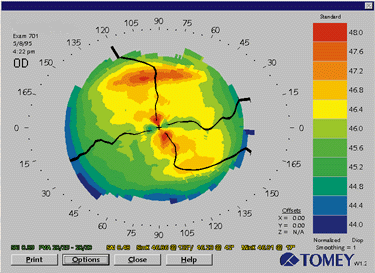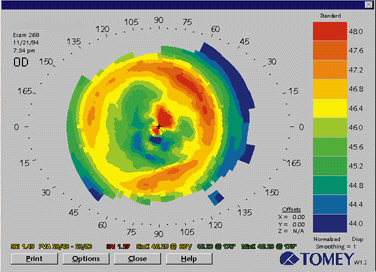Use of lubricating drops before corneal topography debated
GREENSBORO, N.C. — Are lubricating drops a benefit or a detriment to the accuracy of dry eye patients' corneal topography?
According to Philip M. Buscemi, OD, lubricating dry eyes before performing corneal topography creates accurate results. He places one or two drops of Refresh (Allergan) in each dry eye, allows patients to blot excess fluid outside the cornea, then takes the topography after allowing patients a brief moment to get ready. Buscemi said the drops create a reflection.
But Ken Daniels, OD, assistant professor at Pennsylvania College of Optometry, Philadelphia, said he feels using drops can mar results.
"Unless the patient is alacrimal, there's no reason you can't get a picture," said Daniels, director of the Contact Lens Research Program based at the college. Data can be missed if the eyes are artificially wetted, he said.
Buscemi said that while he knows of no research in this area, and there is a debate about "the accuracy of the curvature you get," he has had good results.
 --- Severe dry eye syndrome secondary to treatment for rosacea. Buscemi says eye drops will not change the fundamental pattern caused by a dermatological problem such as this.
--- Severe dry eye syndrome secondary to treatment for rosacea. Buscemi says eye drops will not change the fundamental pattern caused by a dermatological problem such as this.
Without wetting drops, dry eyes often yield "drop-out" areas in topography, indicating no reading. The Tomey machine that Buscemi uses prints a topography in which drop-outs of more than one ring show as black areas in the field of color. Other types of topography devices extrapolate instead, calculating what the topography is likely to be in the missed area. This interpretation can lead the optometrist to miss corneal problems, he said.
Buscemi said he repeats the corneal topography reading in dry eye patients where a problem shows on the map. He said he asks himself, "Is this a misshapen cornea or is it a problem with tear film?"
If the second reading shows a potential problem in the same area, then it is likely to be a true abnormality instead of an unusual reading caused by extra tear flow, he explained.
Buscemi said use of Refresh drops does not change "the fundamental pattern" caused by a dermatological problem in the eye such as eczema or rosacea. The same pattern will emerge on the topography if repeated on the patient, he said.
A more viscous drop, he said, such as Celluvisc (Allergan), which other doctors use for topographies, can skew results.
Daniels said he avoids using drops on dry eye patients. He asks the patient to blink several times prior to image capturing. Multiple blinks will spread the tear film evenly.
Prior to image capture, focusing is completed by observing the tear film motion on the video screen. At this time, a noninvasive evaluation of the tear film can be made. He said it is important to be ready to take an immediate corneal topography as soon as the tears are produced, within 5 seconds.
"If there are holes, I take several pictures," Daniels said. He then uses the differential maps to extrapolate data. It is likely that drop-out areas on one reading will be filled in at least partially on the next, he said.
 --- Darier's disease-associated dry eye syndrome. Darier's is a hereditary condition characterized by papular growths covering the face, scalp and trunk. Dry eyes and corneal deformity should be documented with topography and correlated with periods of reduced visual acuity.
--- Darier's disease-associated dry eye syndrome. Darier's is a hereditary condition characterized by papular growths covering the face, scalp and trunk. Dry eyes and corneal deformity should be documented with topography and correlated with periods of reduced visual acuity.
Daniels noted that the Tomey, Technomed and Par Technology Systems devices produce blank spots on their maps when not enough information is collected, yet have high enough resolution to yield finite detail of the corneal surface exclusive of elevations and depressions.
According to Daniels, in some cases of surface defects the drop-out is very important to see. For example, he uses topographies to monitor the healing of patients with erosions, and hopes that the black areas on their maps will shrink over time with successful treatments.
"In a very severely damaged eye, no machine will take good topography," said Daniels. He said in these cases, he combines topography and photography.
Daniels added that a low-viscosity drop such as saline solution would probably not greatly harm the results from topographies, but a thicker drop such as methylcellulose would.
